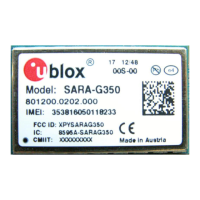SARA-G3 and SARA-U2 series - System Integration Manual
UBX-13000995 - R26 Design-in
Page 153 of 217
2.7.1.3 Guidelines for external analog audio device connection circuit design
The differential analog audio I/O can be used to connect the module to an external analog audio device. Audio
devices with a differential analog I/O are preferable, as they are more immune to external disturbances.
Figure 85 and Table 56 describe the application circuits, following the suggested circuit design-in.
Guidelines for the connection to a differential analog audio input:
The SPK_P / SPK_N balanced output of the module must be connected to the differential input of the
external audio device by means of series capacitors for DC blocking (e.g. 10 µF) to decouple the bias present
at the module output, as described in the left side of Figure 85.
Guidelines for the connection to a single ended analog audio input:
A proper differential to single ended circuit must be inserted from the SPK_P / SPK_N balanced output of
the module to the single ended input of the external audio device, as described in Figure 85 right side: 10 µF
series capacitors are provided to decouple the bias present at the module output, and a voltage divider is
provided to properly adapt the signal level from module output to external audio device input.
Guidelines for the connection to a differential analog audio output:
The MIC_P / MIC_N balanced input of the module must be connected to the differential output of the
external audio device by means of series capacitors for DC blocking (e.g. 10 µF) to decouple the bias present
at the module input, as described in the left side of Figure 85.
Guidelines for the connection to a single ended analog audio output:
A proper single ended to differential circuit must be inserted from the single ended output of the external
audio device to the MIC_P / MIC_N balanced input of the module, as described in the right side of
Figure 85: 10 µF series capacitors are provided to decouple the bias present at the module input, and a
voltage divider is provided to properly adapt the signal level from the external device output to the module
input.
Additional guidelines for any connection:
The DC-block series capacitor acts as high-pass filter for audio signals, with cut-off frequency depending on
both the values of capacitor and on the input impedance of the device. For example: for a differential input
impedance of 600 , the two 10 µF capacitors will set the -3 dB cut-off frequency to 53 Hz, while for single
ended connection to 600 external device, the cut-off frequency with just the single 10 µF capacitor will be
103 Hz. In both cases the high-pass filter has a low enough cut-off for proper frequency response.
Use a suitable power-on sequence to avoid audio bump due to charging of the capacitor: the final audio
stage should be always enabled as last one.
The signal levels can be adapted by setting gain using AT commands (see the u-blox AT Commands
Manual [3], +USGC, +UMGC), but additional circuitry must be inserted if SPK_P / SPK_N output level of the
module is too high for the audio device input or if the audio device output level is too high for MIC_P /
MIC_N, as the voltage dividers present in the circuits described in Figure 85 right side to properly adapt the
signal level.

